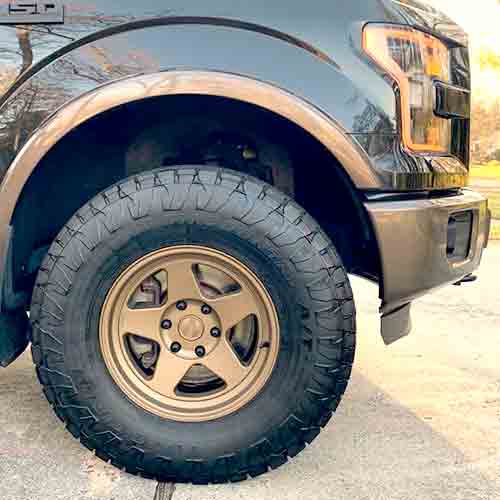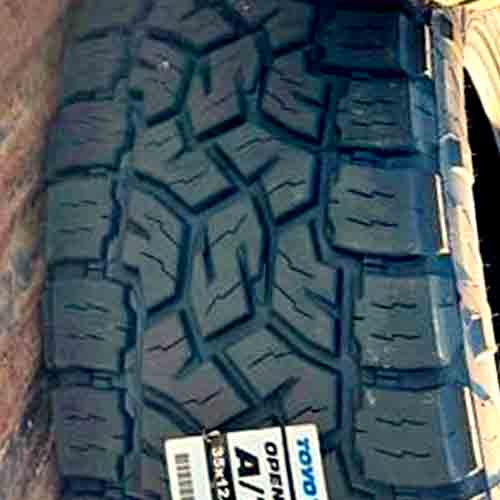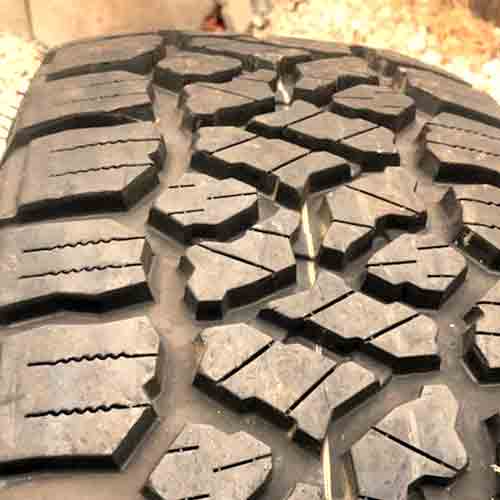Toyo Open Country AT3 and the Kenda Klever AT2 are really good at what they can do, considering they are all-terrain tires. These tires prove that the overall market has made some serious progression over the years. Though which one is a better pick for you? Well, let me save you some time.

In my expert opinion as a tire engineer, the Kenda Klever AT2 brings you with a superior wet and winter traction with it’s next gen compound. And it’s lighter construction allows for superb fuel economy and provides climbing capabilities off-road. Toyo AT3 on the other side, does better when things are dry, and provides a better tread life. And off-road it’s great on rocks, gravel and dirt.
Table of Contents
Quick Specs
The Toyo AT3 comes in 15 to 22 inches, having following specs.
- Speed ratings: Q, R, S, T and H.
- Load ratings of C to F.
- Weight range of 30 lbs to 72 lbs.
- Tread depth ranging from 12.7/32″ to 17/32″.
- 65k miles warranty.
Check out detailed review of Toyo AT3: https://tiredriver.com/toyo-open-country-at3-review/
The Kenda Klever AT2 provides you with 15 to 20 inches rim diameters with following specs:
- Speed ratings: R, S, T and H.
- Load ratings: SL, XL, C and E.
- Weight range: 35 to 60 lbs.
- Tread depth: 14/32″ or 15/32″.
- Ratings: 3PMSF and M+S rated.
- Warranty: 50k (LT), and 60k for P metric sizes.
Review this tire in detail: https://tiredriver.com/kenda-klever-at2-review/
Outer Construction
Starting things off with Toyo Open Country AT3, this tire offers a new generation compound on its tread. So you get a balanced on and off road traction. Let me explain.

Basically in the middle, you get to see S shaped lugs with thick foundational supports underneath. So on roads, you get the required directional grip.
And since the surrounding lugs have notches facing in all directions, and similar full depth siping, you are not left out when things get rugged as well.
Moreover, even though these central lugs are packed up together, they make wide enough circumferential grooves which keep the tread clean.
Though separating them are shoulder lugs, and as they have ridges and more firmer secondary rubber layers underneath, they get to be more on-road oriented.
But yes you can say that the side edges of the staggered blocks, and lugs on sidewalls do help a lot.
And it gets further improved with lowered air pressure.
On the other hand, the Kenda Kelver AT2 provides you with smaller biters in comparison.

Starting form the center, the tread presents you with randomly arranged lugs of various shapes and sizes.
These are actually 3 unique blocks making redundant images with each other, where the central ones (which are arrow-shaped), are slightly chunkier, though they carry similar features such as off-set sides, sharp edged and same rectilinear full depth sipes.
And together they make a map of tread voids running in all directions and joining up with the outer longitudinal channels, and evidently with the lateral shoulder grooves. So you get a great off road traction this way.
And on highways, the tire provides you with directional stability with reinforced foundations, as all lugs are joined up with each other with the help of ridges (which also act as stone ejectors).
Moving towards the shoulders, they are pretty straight forward in comparison.
They have staggered outer edges, and different sipes (which are more interlocking), and towards bead area, they make thick enough sidewall lugs to provide ample tread print off road with lowered air pressure, though they could have been better just like the Toyo AT3.
Internal Construction
Durability is an important factor for off-road tires to effectively handle rough terrains, and most of that comes form the internal plies they get to have.
In case of Kenda Klever AT2. the tire comes with 2 ply polyester cover + 2 steel belts and 2 cap plies of nylon.
The Toyo AT3 on the other side, has similar polyester and steel belts construction, but it only gives you a single cap ply. So overall, its okay to think that this tire is weaker.
And to tell you from experience its P metric sizes are very weak, and definitely not suitable for tough off-road tracks.
Read more: Are A/T tires durable enough?
Dry On-Road Abilities
On dry pavements, there are a lot of factors to consider, so to manage that, I’ve divided this section in to the following parts.
Grip From Middle
The middle grip, stating the obvious, comes form the central area of the tread, and its seen how much contact they make with the ground, the more the better.
Kenda Klever AT2 on the other side, features smaller lugs on the central portion of the tread, surrounding by larger voids so grip gets limited.
Handling Performance
Both tires show up with very similar handling performance, but still out of them the Toyo AT3 gets to take an upper hand, mostly because of it’s more stable connection with the road.
Although both tires have closed up shoulder lugs, with smaller tread voids in between, the ones on Klever AT2 are not as firm. Whereas on Toyo AT3, they have reinforced foundations, and connectors in between.
So during cornering, they not only provide better lateral traction (g forces), but also better steering feedback, as it’s lugs don’t want to flex and bend too much.
For Your Info: Because of the tire’s amazing dry performance, the Toyo AT3 made its way to my list of best all-terrain tires, which you can check here: https://tiredriver.com/best-all-terrain-tires/
Wet Performance
On wet roads, it’s important for a tire to have both good grip and hydroplaning resistance in order to quickly clear water from the surface.
Wet Grip
In terms of wet grip there are two major points to consider.
- Water particles are extracted into the sipes’ slits as they expand, upon contacting the ground.
- And so in order to “expand” properly, they should be flexible.
That’s why you see better results on Kenda Klever AT2, as it’s tread compound is softer and you get more number of sipes, which bend with much more ease.
On the other side, the rigid rubber of Toyo AT3 does not allow sipes to flex as much, and so as a result grip gets limited.
Hydroplaning
Hydroplaning (or a tire’s floating on water), can also be used to further explained, why Toyo AT3 is lacking here. The tire basically has closed up shoulder grooves, having ridges in them (see the tread section above to check them out).
These shoulder connectors restrict the water form leaving the tread, laterally. And so with less water clearing abilities, the overall wet performance is compromised.
The Kenda AT2 on the other side, has more open outer tread voids, and they allow the water to get channeled out hurdle free.
Quality of Ride
A tire’s ride quality is influenced by factors such as noise level, comfort, and its ability to absorb road impacts. I discussed all of them below.
Tread Noise
Unwanted noise is caused by the flow of air, with the majority passing through the shoulder grooves of the tire’s tread.
This air then hits the walls around, in the grooves, generating more unwanted noise waves.
That’s why with more open shoulder voids seen on Kenda Klever AT2, the tire gets to be louder. Whereas on Toyo AT3, this air gets restricted with the help of connectors (seen between the lateral tread voids of shoulder lugs).
On-Road Vibrations
The comfort level of a tire is dependent on its internal design and rubber construction, with a tire featuring a soft internal structure and pliable top rubber providing the best results.
That’s why Klever is better here, featuring pliable composition of rubber, and a malleable internal construction, providing better cushioning to the vibrations of the road.
The Toyo Open Country AT3, however, is hindered by its rigid compound, leading to a rougher ride quality.
Read further about it in –
Do A/T tires cause vibrations: https://tiredriver.com/do-all-terrain-tires-cause-vibrations/
Fuel Consumption
Fuel, simply put, gets consumed more with higher rolling resistance. Yet, how that resistance gets affected is a little tricky to understand.
There are two main things involved here, the tire’s weight and it’s ability to stick on the surface.
And although Kenda Klever AT2 comes with a sticker material, its overall construction is still lighter, and it has less tread depth in comparison. Both of these work to the tire’s advantage, as the with shallower tread voids, the lugs carrying weight on them, don’t get to flex around too much (which of-course wastes energy).
On the other side, the Toyo AT3 although coming in with a heavier built, and more tread depth, still gets to provide similar fuel economy, mainly because of it’s stable tread design with stiffer composition. And this also restrict the bending/flexing of the lugs.
I covered it all extensively in, do A/T tires consume more fuel.
Tread Life
Tread wear is not determined solely by rolling resistance as it mostly thought to be. As here there are other factors involved, which include, tread depth and composition being the major two.
That’s why Toyo AT3 lasts longer in comparison, providing you with 15k more miles in warranty as well.
The tire’s stiffer compound is harder to get burned, and it’s stable lugs formation don’t allow a faster wear rate. Moreover, it also has more tread depth to it’s advantage, so it takes longer to come down to 2/32″ legal limit.
Kenda Klever AT2 on the other side not only comes with shallower tread voids, but it’s softer rubber is also more susceptible to burn quicker in comparison. Though it’s still not too far off, as it comes with 50k miles warranty on LT sizes (and 60k for P metric).
Also Read:
How to Increase tread life?: https://tiredriver.com/how-to-increase-tread-life-on-tires/
Do A/T tires wear faster?: https://tiredriver.com/do-all-terrain-tires-wear-faster/
Off Road Traction
Off-road conditions such as mud terrains can prove demanding, but gravel and dirt roads are more ideal for on-road tires. Let’s explore all terrain possibilities thoroughly.
Desert Traction
When it comes to desert performance, you need to make sure, your tire is floating enough. As if it’s prone to digging, otherwise, that’s it, you’d get stuck.
That’s why Kenda Klever AT2 with a softer rubber build, and sidewall lugs which spread out to enhance overall tread-print with the sand gets to provide better traction values.
Toyo Open Country AT3, on the other side, comes with harder shoulder edges, and they are more susceptible to digging in comparison.
Muddy Trails
The performance of all-terrain tires in mud is often limited by their narrow grooves, which struggle to evacuate mud efficiently.
That’s why a tire with self-cleaning grooves and a more robust tread design is needed for improved traction and stability.
And although both tires here aren’t aggressive enough to handle thicker muddy terrains, you can still get a better traction out of Kenda Klever AT2 (on lighter terrains).
The tire basically provides you with smaller central blocks which cut through the mud more efficiently, and since they are surrounding by wider gaps, mud is able to leave out the grooves in a better way.
Whereas on Toyo Open Country AT3, you get closed up shoulder voids, restricting mud’s flow out through sideways.
Recommended Read –
Are A/T tires good in mud? : https://tiredriver.com/are-all-terrain-tires-good-on-mud/
Rocky Tracks
The ideal tire for navigating rocky terrain must have the following features:
- Lugs capable of gripping at multiple directions.
- Full depth siping (I’ll explain below).
- And powerful sidewalls, with thicker inner make-up, and lugs on top.
And considering all of them, it can be explained why Toyo Open Country AT3 is lacking here comparatively. The tire although has good enough biters in the middle with F shaped lugs providing grip “at multiple angles”. It’s skinnier sidewall lugs and less aggressive shoulders
Kenda Klever AT2 on the other side provides you a lot of smaller biters in the middle with off-set edges providing better gripping abilities, and it’s sidewall lugs are thicker providing enhanced footprint with lowered air pressure.
Winter Traction
Both tires are very competing in this section, and its not easy to pick one over the other here, as there are a lot of variable involved.
Although, both tire are 3 peak mountain snowflake and M+S rated, and they provide good gripping overall, the Kenda Klever AT2 does better when it comes to hard packed snow.
This is because the smaller blocks on it’s tread provide more biting to the ground where the thick siping in the middle and wave-like on the shoulder lugs chew on the snowy surface.
Toyo Open Country AT3 on the other side does well on deeper terrains, where it’s multiple notches (facing at various angles) provide efficient snow biting abilities.
Also Read –
Are A/T tires good in Snow: https://tiredriver.com/are-all-terrain-tires-good-in-snow/
Winding Up
Toyo Open Country AT3 provides you with better dry performance, and tread life on pavements, and on rugged tracks, it brings better traction on rocks.
Kenda Klever AT2 on the other side, features a supple tread compound which yields superior wet and winter traction. And the tire’s lighter weight also allows it to be great for sand climbing and fuel efficiency.